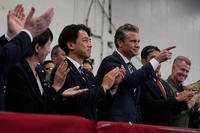The U.S. defense industrial base received a "mediocre C" report-card grade as it struggles to stay ahead of adversaries, such as China, that rely on stealing American military secrets to remain competitive, according to a new report from the National Defense Industrial Association (NDIA).
"Vital Signs 2020: The Health and Readiness of the Defense Industrial Base," a data-based report compiled by NDIA and the data analytics firm Govini, analyzed 44 statistical indicators ranging from potential threats to digital systems to surge capacity over the last three years.
The report then graded eight performance areas -- on a scale of 100 -- for an average grade of 77 for 2019.
Vital Signs "2020's mediocre 'C' grade reflects a business environment characterized by highly contrasting areas of concern and confidence," the report states. "Deteriorating conditions for industrial security and for the availability and cost of skilled labor and materials emerge from our analysis as areas of clear concern."
Related: Report: Pentagon Weapons Systems Vulnerable to Cyber Attacks
The U.S. defense industrial base is "an element of national power and is key to national security," retired Air Force Gen. Hawk Carlisle, NDIA president and CEO, told defense reporters Wednesday during a roundtable discussion on the report's release.
"This is really about encouraging the dialogue. The Department of Defense is well aware of this, and they are working hard on it," Carlisle said, referring to the Pentagon's separate assessment of the defense industrial base it released in 2018.
The intent behind Vital Signs 2020 is to build a path forward from the Pentagon's assessment and begin an annual, unclassified discussion with the public about how the defense industrial base needs to improve.
"I think there is a tendency to say, 'Well, we have the greatest military in the world -- which we do -- and the greatest capability and the greatest equipment in the world' ... but we won't stay that way if we don't address this problem now," Carlisle said.
Vital Signs 2020 rated industrial security as the weakest area of the industrial base, giving it a failing score of 63. Defense contractors have "endured brazen acts of industrial espionage and data breaches by state and non-state actors in recent years," the report states, adding that cyber vulnerabilities within information systems have led to increased security breaches.
"If we look at where we have been over the past 30 years, particularly since the end of the Cold War, our adversaries, China in particular and Russia as well, have attacked our industrial capacity and tried to gain technological superiority," Carlisle said. "If you look at what China has done over those 30 years, they have watched how we fight, they have watched what we have done and attacked us everywhere they can. ... Trillions of dollars a year are taken from our country with intellectual property theft, with data breach ... and unfair trade practices of the Chinese in particular."
The NDIA report gave the area of production inputs a grade of 68, partly because the defense industry workforce has shrunk from 3.2 million in the 1980s to about 1.1 million currently. Another reason for the low rating on production inputs is the backlog of security clearance applications for workers, the report states.
The health of the defense industrial base, however, is stronger in the area of productive capacity and surge readiness, a critical area that earned a higher score of 77, according to the report.
"The capacity of the defense industrial base to grow its output and fulfill a surge in military demand stands as a key test of its health and readiness," the report states. "Productive capacity and surge readiness earned an index score of 77 for 2019, a 9-point increase from its 2017 index score."
The next step is to open a discussion with Pentagon officials, members of Congress and the defense industry to search for solutions that will strengthen the defense industrial base, said Wesley Hallman, NDIA senior vice president of strategy and policy.
"Our goal is to develop an open-sources, data-driven model from which we can assess the health and readiness of the defense industrial base on an annual basis," he said. "We make no specific recommendations; we do this because we want the broader community to see this as a baseline for the discussion."
-- Matthew Cox can be reached at matthew.cox@military.com.
Read More: Pentagon Increases Efforts to Protect Defense Industrial Base














